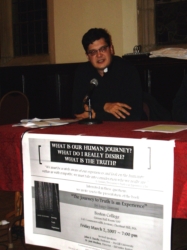New book offers glimpse on origins of movement
BRIGHTON--A book newly translated into English offers insights into the roots of one of the most prominent new movements in the Church.
Communion and Liberation (CL) was founded by Father Luigi Giussani in 1954 when he established a youth group, then known as Gioventù Studentesca (Student Youth), as a response to the disconnect he found between faith and life in the youth in Milan, Italy.
“He had a desire to help people realize the connection between who Christ is and who I am as a human being,” said Father Jose Medina in an interview with The Pilot. Father Medina and McGill University professor John E. Zucci presented the book “The Journey to the Truth is an Experience” at Boston College March 2.
“It was the first book that was ever written about Don Giussani’s experience,” Father Medina said.
The book is a collection of notes taken by the first group of students who gathered around Father Giussani.
“At the beginning of a meeting he would propose a question and invite everyone to answer that question. After the discussion he would provide them with a synthesis,” Father Medina said.
“He desired to present the reasonableness of the faith, in the sense that faith is human, that it is reasonable to believe,” he continued.
“In meeting with this youth, a method developed through a dialogue regarding what the presence [of Christ] says and how do we put ourselves in front of that presence,” he said.
From those initial experiences in Milan, the Communion and Liberation movement expanded worldwide and is now present in 70 countries. Hundred of thousands of people around the world are following the method developed by Father Giussani.
The essence of the charism given to Communion and Liberation can be experienced as a succession of three steps, Father Medina said.
“The first step is to grow in the awareness that we are a reality full of desire and yet, at the same time, full of solitude, full of yearning for someone who seems to be there. All our reality, all our circumstances, seems to point elsewhere.”
“We become more aware of our humanity. That awareness gives us a greater sensibility to be aware of the One that responds to our desires -- that being Christ,” he said.
In the second step, the person is in “awe” of that encounter “to the point that a question arises, a question that is written in the Gospel, ‘Who are You?’”
“That is the discovery that being with ‘You’ corresponds. I perceive a glimpse of that fulfillment that I always desired,” he continued.
“The third step would be how the encounter with Christ, of the event of Christ, continues today, that is the life of the community, that is the body of Christ, that is the Church.”
According to the CL Website, www.clonline.org, the current name of the movement appeared for the first time in 1969 and “synthesizes the conviction that the Christian event, lived in communion, is the foundation of the authentic liberation of man.”
CL does not have members “but only the free participation of persons” the Web site says. The basic instrument for the formation of adherents is weekly catechesis, called the “School of Community.”
“It is the most important moment of the life of the community,” Father Medina said.
“It is a weekly meeting in which we learn to read into what we live and to share our experience of life and to have a glimpse of how we see this answer of Christ in our life,” he said.
Another experience born from the movement are the fraternity groups formed by adults who commit their lives in a desire for holiness.
The fraternity is formed by families, consecrated people and priests who desire to live the communal dimension of the faith together, according to Father Medina.
Father Medina is a member of The Fraternity of the Missionaries of St. Charles Borromeo, a Society of Apostolic Life that aims to take the experience of the movement to the world.
Father Medina also reflected on his personal experience of CL.
“When I was young I always perceived the sacraments as foreign, in relationship with my parents, not in relationship with me,” he said.
“Once I could answer to the question, ‘Who is Christ for me today?’ I was able to grow in the love for the Eucharist and the sacraments. Becoming more and more aware of who He is, I have come to appreciate more the fact that He is present at the Eucharist, as He is present in the Sacrament of Reconciliation and all the other sacraments.”
“The encounter with the movement has created in me a much more clear understanding of who I am as a human being, and also, because Christ is present -- the answer is present -- a continuous understating of who I am and who He is.”



















